It's that time, the great last round-up and round of applause for some of the more sumptuous reads of the past year, as the new offerings begin to spring forth, sure as crocuses. Though it feels as though more and more the shadow of marketing creeps into the creative realm of children's publishing, all the more brightly shine works of sincerity, substance and real risk. Children's books continue to be the source of great learning opportunity and an equalizer of education, genuine learning in an age of testing and stress-ting, and I hope these picks offer a reprieve and and a chance to savor. As I write, I imagine the Powers That Be at the American Library Association, choosing award winners, have titles spread on their table as they are on mine for the most distinguished contributions of 2012. With baited breath, we'll have to wait until tomorrow to see what they decide, but here are my choices:
MORE by I.C. Springman, illustrated by Brian Lies (Houghton Mifflin). An avaricious magpie with a glinting eye fills his nest with bric-a-brac, while a worried mousie friend looks on as the avian maven crosses the line between collector and hoarder. Children will enjoy picking out the familiar tiny treasures being piled up, and every double-page spread lends itself to a little "I Spy" action (Lego, Matchbox car, thumbtack, barrette?). Meanwhile, the illustrator deals in subtle visual acrobatics, moving us from light to shadow and back to light and makes clever use of busy double-paged spreads opening up to the relief of cleared visual space. Though more empathetic than preachy, this book is ultimately moving and timely for readers of any age living in a country where so many take more than their share and where people are increasingly feeling the burden of their possessions. Pictures tell a thousand words in the limited storage space of 32 pages, and most effectively tell a parable of "less is more." This bird's trash definitely becomes our treasure.

retold and illustrated by Helen Ward (Templar). Realistically, I don't know how many books featuring mice the Caldecott committee is allowed to recognize without declaring an infestation (
ONCE A MOUSE,
SEVEN BLIND MICE,
THE STORY OF JUMPING MOUSE,
ALEXANDER AND THE WIND-UP MOUSE and
OWENspring to mind), and Aesop and his fable form has also already enjoyed time in the awards spotlight (
LION AND THE MOUSE,
FABLES), but that does not undermine the undeniable craft that went into this tome. With a line so delicate that it could only be compared to the great
Demi (who really did illustrate with a mouse's whisker), with the turn of every page we are entered into a collided world of a naturalist and an artist, a study in shocking focus and detail (is the sleeping fawn's back going to rise and fall with every breath? It wouldn't be the least bit surprising). The illustrator has the eye and mystifying, almost improbable talent for perspective of a
Van Allsburg, but with more color. The mouse figures are at once impeccably realistic and rendered with affection. In the end, when we give a child a picture book, we want it to be somehow gorgeous. This author/illustrator delivers. If the criteria for the Caldecott was sheer visual beauty, Ward would probably have to win. Gee, what's a girl got to do to take a Caldecott around here?!
Moving from the revered college of Chris Van Allsburg to the celebratory kindergarten of
Mo Willems and the straightforward school of common sense that is
Peter Reynolds, we have
hello, hello! by Matthew Cordell (Hyperion). Here, put down the cell phone and tune in to the simple story of a little girl living in a world of beeping-and-booping, who discovers the power of unplugging and the real meaning of connection. Like Springman's MORE mentioned above, it is a story for our times, and the unfettered, jubilant line is just right for the message that would make Thoreau proud. I would imagine this title is a serious contender for a major award, but regardless of what any committees decide, he has an unusually expressive line, and I stand by my belief that Cordell is the
William Steig of the new Millennium. He is also, to my mind, the author/illustrator of the year, his hard work evidenced by
so many wonderful offerings. As far as I'm concerned, he can accept his accolades now or later. But
hello! He deserves it now.
In fact, connection with nature has been a recurrent theme in the best of this year's crops, notably
STEP GENTLY OUT by Helen Frost and Rick Leider (Candlewick), in which sparse, lilting verse and close-up photography take us on a nature walk from a bug's-eye view. Terrific end-notes describing each creature strongly supplement the elemental sense of wonder, reverence and surprise this book induces, just right for it's intended audience (watch your own child grow wide-eyed, safely face-to-face with an equally curious yellow-jacket!). This book feels very fresh, modern and just right for a new generation of kids looking at a green world when turning away from glowing screens.
Then there is
OUTSIDE YOUR WINDOW: A FIRST BOOK OF NATURE by Nicola Davies, illustrated by Mark Hearld (Candlewick), which is now on my must-add-to-any-newborn-baby-basket list, because why wouldn't you want to give someone new to the planet such a pleasant field guide?
Oversized and beautiful, the multi-media illustrations are relatively muted in palette, full of the gentleness and stylized interest that bring
Brian Wildsmith to mind. Meanwhile, the author! If Matthew Cordell is picture book author of the year, Nicola Davies is certainly non-fiction author of the year. I noticed in a review, to my great consternation, that OUTSIDE YOUR WINDOW was criticized for not having "flow" befitting of poetry, and that is probably because it is not poetry, but in fact great prose in which it matters how it is read aloud; you really have to channel the author and read it not as someone wearing a beret and black turtleneck, but with the zeal of a new grandparent with a small hand in your own, whispering sometimes, pointing sometimes, explaining sometimes. Davies wrote a book on
POOP some years ago (and yes, I know it's about poop and that is undignified in some circles, but when you work with seven-year-old-boys you really ought to know a lot about poop) and I swear I've read it at least eleven times, and not only because I keep it in my bathroom. Her writing is always so engaging, and so well-researched, and so genuine in her enthusiasm for her subject, it is absolutely contagious in the nicest way. She followed it up with several books about nature and living things of high interest to children (
WHAT'S EATING YOU? PARASITES: THE INSIDE STORY and
EXTREME ANIMALS JUST THE RIGHT SIZE: WHY BIG ANIMALS ARE BIG AND WHY LITTLE ANIMALS ARE LITTLEand
TALK, TALK, SQUAWK: A HUMAN'S GUIDE TO ANIMAL COMMUNICATION) that belong in every elementary school library's nonfiction section. This year, she also has an absolutely wonderful "uncover and discover" lift-the-flap series out for the littlest page-turners,
WHO'S LIKE ME?,
WHO LIVES HERE?,
WHAT WILL I BE? and my favorite,
WHAT HAPPENS NEXT? Such fun to see the peacock's tail open up to reveal full plumage, and the little eyeball-looking thing turn into a frog! I'm sorry, I know we're all a little broke, but if you have a preschool child you need ALL of them, because they are the most developmentally-appropriate series of the year, and so colorful and cunning, too.
To the reader/critic who missed a more poetic cadence, I wish I could recommend another great book of this past year,
WATER SINGS BLUE: OCEAN POEMS by Kate Coombs, illustrated by Meilo So (Chronicle):
From "Prayer of the Little Fish":
Keep my gills and keep my fins,
keep me safe in the cool dark,
keep me from the hungry eyes
of the swift and toothful shark.
Find me tender plankton sweet,
help me swim with grace and care,
and please, O Lord, protect me from
the high, dry, breathless air.
The author's assumption of the Christian-Judeo faith of a fish notwithstanding, the sentiment certainly seems right, as does the mood of "Shipwreck":
Here lie the bones
of twenty trees,
lost far from home
under gallons of seas.
Me oh my, such drama captured, and such wit and originality, as the hermit crab takes on the persona of an ocean realtor, a sea urchin falls in love, and the sand tells its own story, all perfectly matched to the flowing art of Meilo So in watercolors (what else?), the master whose magic makes every wave in the ocean as unique as every shell on the shore. A beautiful collection of poetry that is one of the best of the year, and such a warm reading reprieve from the wintry weather.
But winter it is, which brings me to my favorite book of 2012,
TWELVE KINDS OF ICE by Ellen Bryan Obed, illustrated by Barbara McClintock (Houghton Mifflin), one of the rare samples in the under-represented genre of memoir in children's books (
my own notwithstanding).


Now, I know full well that the Newbery Award for distinguished contribution to writing in a children's book usually--and fittingly--goes to a work of fiction, and usually a nice chunky bit of fiction, with chapters and a standard 5.9 x 8.5-ish format, and for that, there are many worthy contenders for excellence, most notably buzzed about this year being
WONDER by R.J. Palacio (Knopf), a paean to kindness about a homeschooled boy with a facial deformity who goes to middle school for the first time;
THE ONE AND ONLY IVAN by Katherine Applegate and illustrated by Patricia Castelao (HarperCollins) based on the true story of a gorilla forced to live in a shopping mall, embodies the power of friendship and is a great animal story to boot (though still was a little too sad for me);
THREE TIMES LUCKY by Sheila Turnage (Dial), a murder-mystery with a cast of zany and regional-voiced characters that would do the ghosts of past Newberys proud (see Kate DiCamillo's
BECAUSE OF WINN DIXIE, Ingrid Law's
SAVVY and Susan Patron's
THE HIGHER POWER OF LUCKY to see what I mean); or my personal favorite of such novels this year,
MAY B. by Caroline Starr Rose (Schwartz & Wade), a compulsively readable historical fiction/survival story cliffhanger in which a girl helping out at a homestead in order to earn money for her family is abandoned at the onset of winter, with little food and the wolves closing in. Best thing since the most biting and exciting chapters of
Laura Ingalls Wilder, and written in that strange, moody why-is-this-written-in-poetry-form-when-it's-slearly-prose-format-that-is-so-overused-but-has-so-few-words-on-a-page-it-makes-things-irresistably-palatable-for-reluctant-readers-so-I-don't-even-care-anymore-I-give-up text layout that young readers so enjoy.
But getting back to TWELVE KINDS OF ICE. I pine for the days of real surprises, when, say, a picture book could win a Newbery award (see Nancy Willard's
A VISIT TO WILLIAM BLAKE'S INN or William Steig's
DR. DE SOTO). Sometimes there is prose that is just so sparkling, and does just exactly what it sets out to do, and deserves reward regardless of format. In this case, Obed sets out to really introduce us to her father, but uses the vehicle of her childhood experience of the changing stages of ice in Maine, as it moves from the pane of glass ("Second Ice") to a homemade rink ("Garden Ice") to the ice of our dreams, and our memories. It can be read as a book about ice skating, winter sports, or a family, or it can be read as a book about the passing of time, sure as Peter Pan. In short, this conversational, reminiscent, well-structured little snowflake of a book performs the triple axel of using writing to connect generations; it is nostalgic in turns, but McClintock's spot illustrations, though keeping with her signature lithograph-like lines, depicts modern children and will hold interest for modern children as well . Sometimes poignant, some times sharp as a skate blade, sometimes warm as a cup of cocoa against crackling joints, Obed uses her skill as a writer to its fullest power: it keeps something alive, it preserves...and shows us that writing can do that.
Speaking of preservation. Alive in our memories are the protesters in the 1963 Birmingham Children's March, captured in all their primary source glory in the wonderful nonfiction
WE'VE GOT A JOB: THE 1963 BIRMINGHAM CHILDREN'S MARCH by Cynthia Levinson (Peachtree).

When the grown-ups failed to desegregate the powder-keg that was Birmingham as civil rights was still just getting a foothold, thousands of brave children followed Dr. Martin Luther King's suggestion to flood the jails with their presence. The bravery of four of these participants is the focus of this well-researched documentary-in-a-book, also overflowing with back and white photographs from the period. It's meaty, intelligent writing, far from facile, laid out in digestible columnar format to keep it from overwhelming middle-schoolers, who will be inspired by this important chapter in both children's and African American history. With the new, national Common Core curriculum putting an emphasis on non-fiction, this is a prime example of what good literature in that context should look like; besides being a read for kids completely in line with a middle-schooler's developmental need to envision and make a difference, there are so many segues for discussion and teachable moments, so much so that I bought a dozen hardcover copies out of my own pocket to perfectly supplement our 7th grade reading of Christopher Paul Curtis'
THE WATSONS GO TO BIRMINGHAM, 1963 and was so pleased to discover the supplementary
website that includes a really excellent teacher's guide. The children so looked forward to their time to read it and came up with
so many good questions of their own. This book came out earlier in the year and I certainly hope it is remembered, along with the history it holds.
You know I'm a sucker for a
good picture book biography, one of the most exciting genres of children's literature, and it so happens that two of the best this year also focus on African American (a.k.a. American!) history, as well as the power of artists to create change.
HARLEM'S LITTLE BLACKBIRD: THE STORY OF FLORENCE MILLS by Renée Watson, illustrated by Christian Robinson (Random House), follows the timeline of a woman who, at the turn of the century as a little girl, thought her voice chased a storm away, and wondered, "if my voice is powerful enough to stop the rain, what else can it do?" Turns out, quite a bit, as Florence's dancing and singing paved the way for other performers, and tried to clear away the clouds of Jim Crow. Bold and folksy was Florence, and so are the illustrations. See if you don't cry at the last double-page spread, as a sky full of blackbirds careens over Harlem. Too few children (and grown-ups!) know about the Harlem Renaissance and the impossibly wonderful contributions made; let this open the book on that knowledge (and you can also find supplemental information/treasures on Florence Mills
here). Also, check out the biography
IT JES' HAPPENED: WHEN BILL TRAYLOR STARTED TO DRAW by Don Tate, illustrated by R. Gregory Christie (Lee & Low);
I have been a long-time fan of Christie's distinctive and recognizable style since he decorated Tony Medina's
LOVE TO LANGSTON, but this year's offering suggests a departure and versatility, as Christie seems to be new and refreshed, channeling the style of the painter Traylor in the illustrations of his life. Well-matched is the writing by Don Tate, which is really excellent; it's hard to write about the life of someone without oversimplifying it, and Tate definitely has the gift of condensation, taking a very big story and pulling out the most important parts for the intended audience and delivering in the most direct language, but still keeping it warm and human and interesting (bringing to mind the great read-aloud by Kathleen Krull about Cesar Chavez,
HARVESTING HOPE). The refrain "he saved up memories of these times deep inside" comes around in a most satisfying circle for both reader and the subject of the book. Cornered by loneliness and misfortune, Traylor draws from his past to create a future as an artist, and offers us evidence of the most hopeful sort that things can get better. Don Tate is a shoe-in for the
Steptoe Award, but regardless, we can all look forward to whatever next this new talent pens.
And finally, though I would be very, very surprised if this won any big awards, I must share one of my favorite books of the year,
MEET AT THE ARK AT EIGHT by Ulrich Hub, illustrated by Jorg Muhle (Eerdmans).

There are a great many dissertations written about the subversiveness of children's literature and a great many conversations had, and anyone claiming to be interested in the subject and doesn't have a look at this title is lying. In this short chapter book, a rather agnostic little penguin is stowed away on Noah's Ark by two friends who, while not necessarily in agreement with their associate's belief system, would rather not see him perish. All the while, the threesome is relentlessly hectored by a conscientious seagull, who smells something fishy in the state of Denmark (or on board the ark, as the case may be). The spot illustrations are cartoonish and the banter verges on silly, but I wouldn't be too quick to dismiss the content as flippant (or flipper-ant, again, as the case may be). In many ways, this book is extremely brave, realistically depicting the tug-of-war between science and religion, modeling critical thinking and putting in print the kind of existential "why?" questions that are very real and pressing to children in a frank, conversational context, even offering more than one answer, which for some, is wonderful, and for others, may be a Horseman of the Apocalypse. In fact, this book is as irreverent, provocative and unconventional as a Mel Brooks movie, and won't find happy landings at many of the more religiously conservative homes in America (for those folks,
FIRST PRAYERS by Troy Howell might be a more proper pick). In fact, it doesn't seem very American at all, mostly because it's not, the team is German, making it eligible for a
Batchelder Award at best. I'd like to believe it would. But like the penguin, my faith is not absolute. I am, however, absolutely sure that a certain kind of reader will both laugh out loud several times, and think in new directions. I did. Share with your young scientist, nihilist or existentialist.
And of course, I will keep my fingers crossed that my dear
Johnny finds all his friends. But that is definitely a biased opinion, one that every author/illustrator has for his or her own. Insert smiley/winky face here.

Besides these "best of's," more favorites for you and your families and students to discover and savor are in the list below, the 2012 PlanetEsme Picks, chosen from hundreds upon hundreds of titles this past year for their exemplary charm, value in classrooms, artistic excellence and consideration of their intended audience! Please excuse that I have not included many great additions to series here, or the list would become unwieldy; I trust that when you find a favorite, you will follow the author where he or she may lead. Truly, there is a great education for all children to be found within these bindings. Please share your opinions, additions to the list, and general book-loving enthusiasm in the comments below. Congratulations in advance to the winners of the ALA awards, and to everyone who reads aloud to children, whether the books have medals on them or not, as we strive to connect children to the best the world has to offer, and to each other.
PICTURE BOOKS
APPLE CAKE: A RECIPE FOR LOVE by Julie Paschkis (Harcourt)
AUNTIE YANG’S GREAT SOYBEAN PICNIC by Ginnie Lo (Lee & Low)
BABY BEAR SEES BLUE by Ashley Wolff (Beach Lane)
BACK TO FRONT AND UPSIDE DOWN! by Claire Alexander (Eerdmans)
BAT AND RAT by Patrick Jennings (Abrams)
BEAR HAS A STORY TO TELL by Philip C. Stead (Roaring Brook)
A BIRTHDAY FOR BEAR by Bonnie Becker (Candlewick)
BOY AND BOT by Dan Yaccarino (Knopf)
THE CHICKEN PROBLEM by Jennifer Oxley and Billy Aronson (Random House)
CHLOE AND THE LION by Mac Barnett (Hyperion)
CHRISTMAS AT THE TOY MUSEUM by David Lucas (Candlewick)
THE CHRISTMAS QUIET BOOK by Deborah Underwood (Houghton Mifflin)
CHOPSTICKS by Amy Krouse Rosenthal (Hyperion)
CINDERELLA illustrated by Jane Ray (Candlewick)
COLD SNAP by Eileen Spinelli (Knopf)
CRAFTY CHLOE by Kelly DiPuccio (Atheneum)
DAY BY DAY by Susan Gal (Knopf)
DRAGONS LOVE TACOS by Adam Rubin (Dial)
EXTRA YARN by Mac Barnett (Balzer & Bray)
THE FANTASTIC FLYING BOOKS OF MR. MORRIS LESSMORE by William Joyce (Atheneum)
FIND A COW NOW! By Janet Stevens and Susan Stevens Crummel (Holiday House)
FRANKENSTEIN: A MONSTROUS PARODY by Ludworst Bemonster (Feiwel and Friends)
FRISKY BRISKY HIPPITY HOP by Susan Lurie (Holiday House)
GANESHA’S SWEET TOOTH by Emily Haynes and Sanjay Patel (Chronicle)
GEM by Hollie Hobbie (Little, Brown)
GOLDEN DOMES AND SILVER LANTERNS: A MUSLIM BOOK OF COLORS by Hen Khan (Chronicle)
GOLDILOCKS AND THE THREE DINOSAURS by Mo WIllems (Balzer & Bray)
GREEN by Laura Vaccaro Seeger (Roaring Brook)
HARRY GOES TO DOG SCHOOL by Scott Menchin (Balzer & Bray)
HELLO! HELLO! By Matthew Cordell (Disney Hyperion)
A HEN FOR IZZY PIPPIK by Aubrey Davis (Kids Can Press)
A HOME FOR BIRD by Philip C. Stead (Roaring Brook)
HOUSE HELD UP BY TREES by Ted Kooser (Candlewick)
HOW DALIA PUT A BIG YELLOW COMFORTER INSIDE A TINY BLUE BOX: AND OTHER WONDERS OF TZEDAKAH by Linda Hller (Tricycle)
HUBBLE BUBBLE GRANNY TROUBLE by Tracey Corderoy (Nosy Crow)
I LIKE OLD CLOTHES by Mary Ann Hoberman (Knopf)
JIMMY THE GREATEST by Jairo Buitrago (Groundwood)
A KISS LIKE THIS by Mary Murphy (Candlewick)
LEMONADE IN WINTER by Emily Jenkins and G. Brian Karas (Schwartz & Wade)
THE LEPRECHAUN UNDER THE BED by Teresa Bateman (Holiday House)
LITTLE SWEET POTATO by Amy Beth Bloom (Katherne Tegen/HarperCollins)
THE MAGICAL LIFE OF MR. RENNY by Leo Timmers (Gecko Press)
MAISY GOES ON A SLEEPOVER by Lucy Cousins (Candlewick)
MINETTE’S FEAST by Susanna Reich (Abrams)
MORE by I.C. Springman (Houghton Mifflin)
NIGHT KNIGHT by Owen Davey (Templar)
NIGHTTIME NINJA by Barbara DaCosta (Little, Brown)
THE OBSTINATE PEN by Frank Dormer (Henry Holt)
OH NO, GEORGE! by Chris Haughton (Candlewick)
ONE COOL FRIEND by Toni Buzzeo (Dial)
ONE SPOTTED GIRAFFE: A COUNTING POP-UP BOOK by Petr Horacek (Candlewick)
PIGS IN PAJAMAS by Maggie Smith (Knopf)
PINCH AND DASH MAKE SOUP by Michael Daley (Charlesbridge)
PUZZLED BY PINK by Sarah Frances Hardy (Viking)
RALPH TELLS A STORY by Abby Hanlon (Amazon Children’s Publishing)
ROOM FOR THE BABY by Michelle Edwards (Random House)
SPOONFUL! by Benoit Marchon (Houghton Mifflin Harcourt)
STEP GENTLY OUT by Helen Frost and Rick Lieder (Candlewick)
THIS IS NOT MY HAT by Jon Klassen (Candlewick)
TIME FOR A HUG by Phillis Gershator and Mim Green (Sterling)
TRAINS GO by Steve Light (Chronicle)
THE TOOTH MOUSE by Susan Hood (Kids Can)
THE TOWN MOUSE AND THE COUNTRY MOUSE illustrated by Helen Ward (Templar)
UNSPOKEN by Henry Cole (Scholastic)
THE WAYSIDE by Julie Morstad (Drawn and Quarterly)
WHAT CAN A CRANE PICK UP? By Rebecca Kai Dotlich (Knopf)
WHAT HAPPENS NEXT? by Nicola Davies (Candlewick)
WHAT WILL I BE? by Nicola Davies (Candlewick)
WHERE’S WALDO?: THE WOW COLLECTION by Martin Handford (Candlewick)
WHO PUSHED HUMPTY DUMPTY? AND OTHER NOTORIOUS NURSERY TALE MYSTERIES by David Levinthal and John Nickle (Schwartz & Wade)
WHO’S LIKE ME? by Nicola Davies (Candlewick)
A WORLD OF FOOD: DISCOVER MAGICAL LANDS MADE OF THINGS YOU CAN EAT! By Carl Warner (Abrams)
YOU GET WHAT YOU GET by Julie Gassman (Little Boost/Capstone)
NONFICTION
ABRAHAM LINCOLN AND FREDERICK DOUGLASS: THE STORY BEHIND AN AMERICAN FRIENDSHIP by Rissell Freedman (Clarion)
ALEX THE PARROT: NO ORDINARY BIRD by Stephanie Spinner (Knopf)
ANNIE AND HELEN by Deborah Wilkinson and Raul Colon (Schwartz & Wade)
THE BIG GREEN BOOK OF THE BIG BLUE SEA by Helaine Becker (Kids Can Press)
THE BEETLE BOOK by Steve Jenkins (Houghton Mifflin)
BEYOND COURAGE: THE UNTOLD STORY OF JEWISH RESISTANCE DURING THE HOLOCAUST by Doreen Rappaport (Candlewick)
BIRDS OF A FEATHER by Pittau & Gervais (Chronicle)
A BLACK HOLE IS NOT A HOLE by Carolyn Cinami DeCristofano (Charlesbridge)
BOMB: THE RACE TO BUILD—AND STEAL—THE WORLD’S MOST DANGEROUS WEAPON by Steve Sheinkin (Flash Point)
BON APPÉTIT! THE DELICIOUS LIFE OF JULIA CHILD by Jessie Hartland (Schwartz & Wade)
THE BOOK OF BLOOD: FROM LEGENDS AND LEECHES TO VAMPIRES AND VEINS by HP Newquist (Houghton Mifflin)
THE BOY WHO HARNESSED THE WIND by William Kamkwamba and Bryan Mealer (Dial)
THE CAMPING TRIP THAT CHANGED AMERICA: THEODORE ROOSEVELT, JOHN MUIR AND OUR NATIONAL PARKS by Barb Rosenstock (Dial)
CITY CHICKENS by Christine Heppermann (Houghton Mifflin)
CLOSELINE CLUES FOR JOBS PEOPLE DO by Kathryn Heling (Charlesbridge)
EARTH FRIENDLY BUILDINGS, BRIDGES AND MORE: THE ECO-JOURNAL OF CORRY LAPONT by Etta Kaner (Kids Can Press)
EDGAR ALLAN POE’S PIE: MATH PUZZLERS IN CLASSIC POEMS by J. Patrick Lewis (Harcourt)
ELECTRIC BEN: THE AMAZING LIFE AND TIMES OF BENJAMIN FRANKLIN by Robert Byrd (Dial)
FAITH: FVE RELIGIONS AND WHAT THEY SHARE by Dr. Richard and Michele Steckel (Kids Can Press)
FIRST GIRL SCOUT: THE LIFE OF JULIETTE GORDON LOW by Ginger Wadsworth (Clarion)
FIRST MOTHERS by Beverly Gherman and Julie Downing (Clarion)
FIRST PRAYERS: A CELEBRATION OF FAITH AND LOVE by Troy Howell (Sterling)
GEORGIA IN HAWAII by Yuyi Morales (Harcourt)
THE GREATEST LIAR ON EARTH by Mark Greenwood (Candlewick)
HANDS AROUND THE LIBRARY: PROTECTING EGYPT’S TREASURED BOOKS by Karen Leggett Abouraya (Dial)
HARLEM’S LITTLE BLACKBIRD: THE STORY OF FLORENCE MILLS by Renée Watson (Random House)
HOW MANY JELLY BEANS? By Yancey Labat (Chronicle)
HOW TO BE A DETECTIVE by Dan Waddell (Candlewick)
I LAY MY STITCHES DOWN: POEMS OF AMERICAN SLAVERY by Cynthia Grady (Eerdmans)
ISLAND: A STORY OF THE GALAPAGOS by Jason Chin (Flash Point)
IT JES’ HAPPENED: WHEN BILL TAYLOR STARTED TO DRAW by Don Tate (Lee & Low)
JUST AS GOOD: HOW LARRY DOBY CHANGED AMERICA’S GAME by Chris Crowe (Candlewick)
KING ARTHUR’S VERY GREAT GRANDSON by Kenneth Kraegel (Candlewick)
LITTLE WHITE DUCK: A CHILDHOOD IN CHINA by Na Liu (Graphic Universe)
MASTER OF DECEIT: J. EDGAR HOOVER AND AMERICA IN THE AGE OF LIES by Marc Aronson (Candlewick)
MINETTE’S FEAST: THE DELICIOUS STORY OF JULIA CHILD AND HER CAT by Susanna Reich (Abrams)
MRS. HARKNESS AND THE PANDA by Alicia Potter (Knopf)
MYTHMAKER: THE LIFE OF J.R.R. TOLKEIN by Anne E. Neimark (Harcourt)
NOAH WEBSTER AND HIS WORDS by Jeri Chase Ferris (Houghton Mifflin)
OUT OF THIS WORLD: POEMS AND FACTS ABOUT SPACE by Amy Sklansky (Knopf)
OUTSIDE YOUR WINDOW: A FIRST BOOK OF NATURE by Nicola Davies (Candlewick)
A PASSION FOR VICTORY: THE STORY OF THE OLYMPICS IN ANCIENT AND EARLY MODERN TIMES by Benson Bobrick (Knopf)
POEM RUNS: BASEBALL POEMS by Douglas Florian (Harcourt)
A ROCK IS LIVELY by Dianna Hutts Aston (Chronicle)
SEEING SYMMETRY by Loreen Leedy (Holiday House)
SMALL AND TALL TALES OF EXTINCT ANIMALS by Damien Laverdunt (Lerner)
A STICK IS AN EXCELLENT THING: POEMS CELEBRATING OUTDOOR PLAY by Marilyn Singer (Clarion)
A STRANGE PLACE TO CALL HOMSE: THE WORLD’S MOST DANGEROUS HABITATS AND ANIMALS THAT CALL THEM HOME by Marilyn Singer (Chronicle)
UNUSUAL CREATURES: A MOSTLY ACCURATE ACCOUNT OF THE WORLD’S STRANGEST ANIMALS by Michael Hearst (Chronicle)
WATER SINGS BLUE by Kate Coombs (Chronicle)
WE’VE GOT A JOB: THE 1963 BIRMINGHAM CHILDREN’S MARCH by Cynthia Levinson (Peachtree)
WHAT WILL YOU BE, GRANDMA? By Nanette Newman (Templar)
YOU ARE A LION! AND OTHER FUN YOGA POEMS by Taeeun Yoo (Penguin)
FICTION
ALMOST HOME by Joan Bauer (Viking)
BEHIND THE BOOKCASE by Mark Steensland (Delacorte)
BIG, BAD SHEEP by Bettina Wegenast (Eerdmans)
CROW by Barbara Wright (Random House)
CRUNCH by Leslie Connor (Katherine Tegen Books)
DRAMA by Raina Telgemeier (Graphix)
EARTHLING! By Mark Fearing and Tim Rummel (Chronicle)
EARWIG AND THE WITCH by Diana Wynne Jones (Greenwillow)
GLORY BE by Augusta Scattergood (Scholastic)
HOMESICK by Kate Klise (Feiwel and Friends)
KAYTEK THE WIZARD by Janusz Korczak (Penlight)
MAGICALAMITY by Kate Saunders (Delacorte)
MALCOLM AT MIDNIGHT by W.H. Beck (Houghton Mifflin)
MEET AT THE ARK AT EIGHT by Ulrich Hub (Eerdmans)
MR. AND MRS. BUNNY DETECTIVES EXTRAORDINAIRE by Polly Hovarth (Schwartz & Wade)
MRS. NOODLEKUGEL by Daniel Pinkwater (Candlewick)
MY MIXED-UP BERRY BLUE SUMMER by Jennifer Gennari (Houghton Mifflin)
OLIVIA BEAN, TRIVIA QUEEN by Donna Gephart (Delacorte)
ONE OF THE MURPHYS by Lynda Mullaly Hunt (Nancy Paulsen Books)
RABBIT AND ROBOT: THE SLEEPOVER by Cece Bell (Candlewick)
SERAPHINA by Rachel Hartman (Random House)
SECRETS FROM THE SLEEPING BAG by Rose Cooper (Delacorte)
WINTER ACCORDING TO HUMPHREY by Betty Birney (Putnam)
SOPHIA’S WAR by Avi (Beach Lane)
SPLENDORS ABD GLOOMS by Laura Amy Schlitz (Candlewick)
THE FIREFLY LETTERS: A SUFFRAGETTE’S JOURNEY TO CUBA by Margarita Engle (Holt)
THE LIONS OF LITTLE ROCK by Kristin Levine (Putnam)
THE MIGHTY MISS MALONE by Christopher Paul Curtis (Wendy Lamb)
THE ONE AND ONLY IVAN by Katherine Applegate (HarperCollins)
THE SUPERHEROES EMPLOYMENT AGENCY by Marilyn Singer (Clarion)
THE WONDROUS JOURNALS OF DR. WENDELL WELLINGTON WIGGINS by M.M. Blume (Knopf)
THE YEAR OF THE BOOK by Andrea Cheng (Houghton Mifflin)
THREE TIMES LUCKY by Sheila Turnage (Dial)
TUA AND THE ELEPHANT by R.P. Harris (Chronicle)
WELCOME TO SILVER STREET FARM by Nicola Davies (Candlewick)
LOOKING FOR ME by Betsy Rosenthal (Houghton Mifflin)
WHO COULD IT BE AT THIS HOUR? By Lemony Snicket (Little, Brown)
WONDER by R.J. Palacio (Knopf)
Happy reading!
Links are provided for informational use. Don't forget to support your local bookseller.
More Esmé stuff at www.planetesme.com.
Now, those of you that know me know that I am all about Johnny Appleseed and have been for a long time. So I am especially pleased to announce the release/book birthday of my new picture book biography, SEED BY SEED: THE LEGEND AND LEGACY OF JOHN “APPLESEED” CHAPMAN, illustrated by the great and mighty Lynne Rae Perkins.
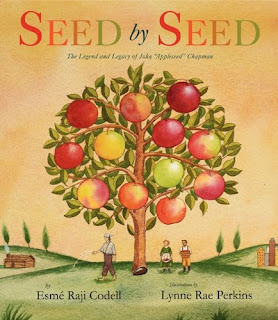
Buses and cars speeding by.
Red lights and green lights and yellow lights and white lights.
Our country is hard and electrical and moving.
But it was not always this way.
Once it was a tangle,
A tangle,
A tangle,
Of roots and branches and wide tree trunks…
And in this quiet, tree-bough-tangled world,
The world before the cement was poured
And the lights turned on,
There lived a man of his time:
John Chapman, better known
As Johnny Appleseed…
He never drove a car
Or sent a basketball flying through a hoop.
He never acted in front of a camera.
He never wore a medal.
He grew apples, and offered them to the pioneers heading west.
But wait. So what?
A farmer. Why should we remember today,
More than two hundred years later,
And call him a hero?Besides being a president of my own private chapter of the Johnny Appleseed Fan Club, I had an ulterior motive for writing
SEED BY SEED. As an elementary teacher and a K-8 school librarian, I was having a really hard time finding a book about Johnny Appleseed that contained what I wanted to share about him. My go-to was Aliki’s charmer,
THE STORY OF JOHNNY APPLESEED , which gave a straightforward story of Chapman’s legend, including clear pictures of covered wagons and straightforward text that allowed me to put Chapman’s life in a historical context (albeit with some explanation behind
stereotypical book treatment of the Native Americans). I also love and use Reeve Lindbergh’s
JOHNNY APPLESEED, verse flanked by helpful map endpapers. Let's face it, there wasn't any shortage of
Johnny Appleseed books.
But what I was really looking for was a book that not only walked through the narrative of John Chapman’s storied life, but one that would make the legend of Johnny Appleseed
relevant to the modern, urban readers in the Chicago Public Schools, the children with whom I was reading. The question wasn't "who was Johnny Appleseed?" The question was, "Why should we care who he was?" I wanted a book that made readers love Johnny Appleseed, be inspired by him and want to emulate his example, even over the distance of history. I had that experience, and I wanted to share it. So the first thing I did in approaching
SEED BY SEED was think, what is it about John Chapman that transcends time? What about him touches me in both a secular way and a spiritual way, and how can that been written about so it will touch someone else?
So I tried to write a book that mirrored what I teach. And when I teach about Johnny Appleseed, I distill the main ideas of his life into “five footsteps,” or ways he lived by example, which are enumerated in the book:
Use what you have.
Share what you have.
Respect nature.
Try to make peace where there is war.
You can reach your destination by taking small steps.
I use the idea of footsteps to suggest that Chapman laid a path for us to follow, both as Americans and as citizens of the world. Each footstep can be discussed, as they are in the book, in the context of Chapman’s biography, but they can also be discussed in the context of the child’s own experience. When has the child shared, or made do, or persevered, bit by bit? These relatable points make John Chapman a real person and a relevant model today, a mentor, a hero that belongs to them! I want children to see that, hey, it’s not just the people who we see on screens that can help to set us on our path. There are so many people in history that can do that for us. Children can research and
read about their own historical figures, and determine what “footsteps” they have left for us to fill. And as a teacher, who am I kidding? Johnny's Five Footsteps also make for a very nice bulletin board concept; I put one up every year. Post a link to a picture of your own original "Five Footstep" bulletin board in the comments section of this post by September 12th, 2012, and you'll be entered in a drawing for an autographed copy of SEED BY SEED inscribed for your classroom library, though everyone who sends a picture will get an autographed bookplate!
Another aspect of
SEED BY SEED I am very excited about has to do with the idea of a legend. What’s fact in a story, and what’s fiction? Is it true that John Chapman donned a tin pot on his head, slept in the same log as a bear, was visited by angels? John Chapman as a historical figure is an enigma. Many books even for grown-ups haggle over what’s real and what is hyperbole. I have been investigating John Chapman for years, and a selected list of resources is at the beginning of the book. One that really interested me especially in my research was an article from the November, 1871 issue of Harper’s Magazine,
“Johnny Appleseed, a Pioneer Hero,” because it was more of a primary source, with accounts given by people who might have actually crossed paths with him…
might have. I love that Johnny’s story inspires so much scrutiny. Even in reviews for this book thus far, there seems to be an emphasis on fact-checking and argument, and I love it. It’s just another aspect that lends relevancy to the modern age, when we should be check-double-checking facts, and assessing credibility of sources. Good heavens, that warms the coddles of my little librarian heart! I hope
SEED BY SEED will be used to help children explore these skills, and I imagine that read in conjunction with Deborah Hopkinson’s wonderful book
ABE LINCOLN CROSSES A CREEK: A TALL, THIN TALE, it should inspire some serious discussion and critical thinking across the grade levels about how history might be revised, and where the seed of truth rests in storytelling.

One person who really did her homework was Lynne Rae Perkins. She writes about her process in creating pictures for SEED BY SEED
here, and you can look at some of the finished illustrations
here. Thank you, Lynne Rae, for bringing this tribute to life! Though I know she is most famous for her Newbery-award winning
CRISS-CROSS, I fell in love with her illustrations in
SNOW MUSIC and
THE BROKEN CAT. I heard her speak many years ago, and was very much in awe of the gravity she afforded each detail and decision in her books. For
SEED BY SEED, her pictures bridge the gap between now and then with a bit of Narnia-like time travel magic, just what I would have hoped, starting and ending on a modern note, with a window into the pioneer past in between. I was especially thrilled and sighing out loud that she chose a model who reminded her of work by the great
Barbara Cooney, especially since I always wondered why Madame Cooney never wrote a book about Johnny Appleseed, it seemed like such a perfect match (and
MISS RUMPHIUS seemed related to Johnny as a distant aunt, anyway). Did you know, illustrators and authors don’t usually communicate directly in the creation of a book? So it was a special delight to realize we were on the “same page.” If I may put on my reviewer’s hat (or tin pot, as the case may be), I was also so enraptured by her mixed media approach. Most show-stopping is her embroidered double-page spread speckled with ripe fruit. My personal favorite in the whole book is the painting on wood of two hands outstretched, a banner for “try to make peace where there is war.” Her diverse use of frames, spreads and headings makes me happy from a teacherly Common-Apple-Core point of view, because I know that I could/would/will use it to help children recognize visual cues for attacking nonfiction. Of course, I don’t think Lynne Rae intended that. She’s just a natural, just like Johnny. A perfect pairing.
The back page of
SEED BY SEED has suggestions for a celebration, “A Johnny Appleseed Anniversary,” and of course, a how-to for apple pie, Johnny’s favorite dessert, which I make religiously on his birthday, September 26th. Because, with all respect to my very fine husband, I am in love with Johnny Appleseed. Johnny Appleseed is my historical boyfriend; he could be my
Daguerreotype Boyfriend, except there are no photos taken of him, just a few drawings. No matter. In my heart and mind’s eye, I know just how he is: from his grungy Phish-show-esque bare feet to his gait, tilted either from navigating gnarly roots underfoot or hard cider. I see the rectangular lump in his shirt, where he is carrying his copy of
Swedenborg, or part of it. I see his smile, thin and chapped and wrapped in his grizzly beard, and his eyes, weary from the reflection of river water and worry over the latest rough exchange with family or hard news from one warring side or another, and yet still with a glint borne of the distracting delight of the sight of a tree, heavy with apples, that took root first under his hand, or better yet, a sapling, swaying jauntily on the back of a wagon bed heading west. I see you, Johnny, and I feel you, and I dedicate
SEED BY SEED to all that is true to your memory and to your invention. I know you, and I want everyone to know you, Johnny Appleseed, especially now, when we need you and your footsteps so much!
I wrote this book because Johnny Appleseed is my American hero. He changed the landscape of our country by planting seeds every day, and he inspires me to think what seed I can plant every day that might, likewise, change the landscape of my country. For me, that seed is read-aloud to children. And now, as the last page of
SEED BY SEED asks, as Johnny’s example provokes:
What seed will you plant?
Illustration of Johnny Appleseed from the Ohio Historical Society, posted on Ohio History Central.
Monument, Richland Historical Society.
PlanetEsme.com linoleum print courtesy of Jim Pollock at PollockPrints.com.
Links are provided for informational use. Don't forget to support your local bookseller.
More Esmé stuff at www.planetesme.com.



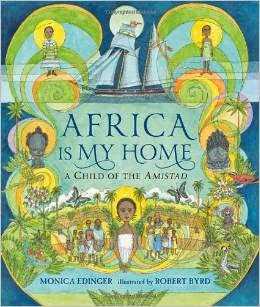





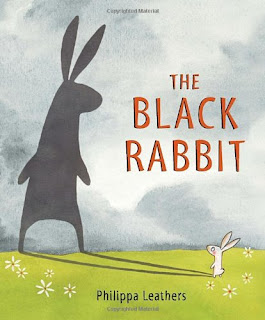

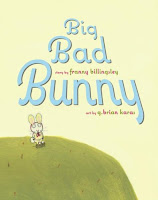
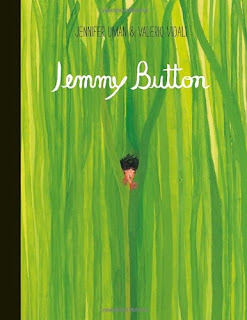






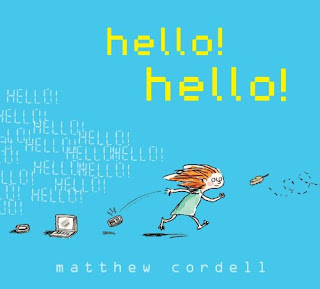













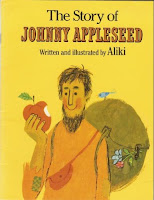
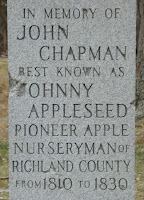









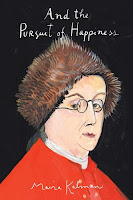





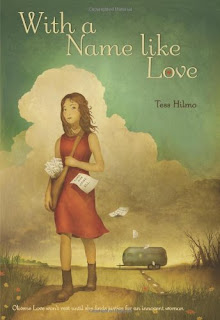










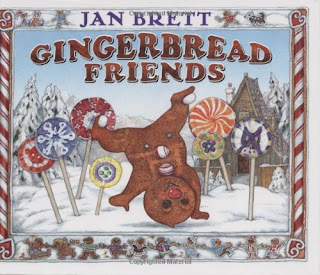
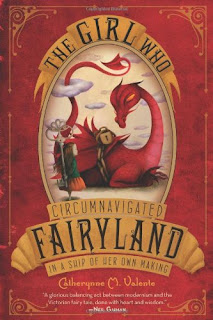



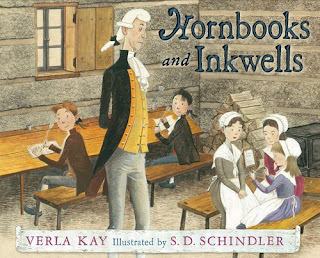












Thanks for sharing these. I can definitely see The Day the Crayons Quit as being an encouragement for readers to get out their own crayons and explore the artist within :)
These are two I cannot wait to check out!!